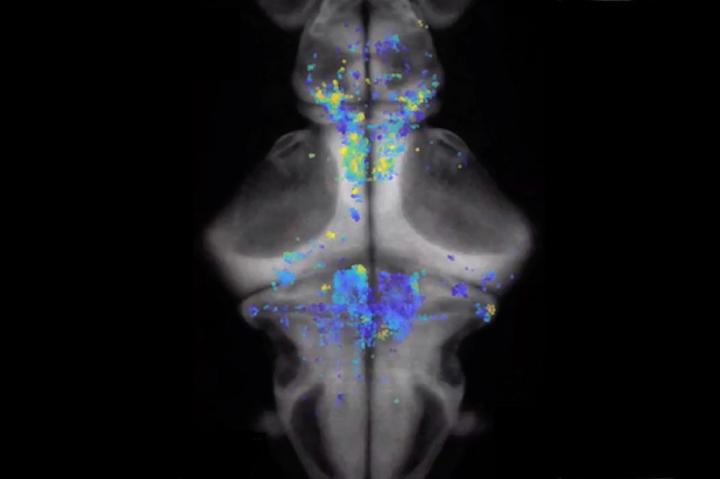
Credit: Laboratory of Neurotechnology and Biophysics
Some things we do appear almost automatic, like opening the fridge when feeling hungry or flipping on the air conditioning when the temperature rises. Although such decisions don’t seem to take much thought, they are in fact generated by millions of neurons and numerous interactions among several brain regions–a dynamic system so complex that scientists aren’t able to observe it fully and in real time, even in simple organisms.
One exception is the zebrafish, whose decision-making processes is now coming into clearer view. In work published in Cell, researchers were able to track the activity of each neuron in the entire brain of zebrafish larvae and reconstruct the unfolding of neuronal events as the animals repeatedly made “left or right” choices in a behavioral experiment.
The resulting frame-by-frame view of a decision in the making was so detailed that, 10 seconds before the fish responded, the researchers could predict what their next move will be and when they would execute it.
Following a decision
Understanding how a brain makes decisions involves tracking how neurons across multiple brain regions respond and cooperate–which, to be clear, is anything but trivial. Scientists have long been stuck between two options: They can either closely observe the firing of only a subset of neurons, which limits their view of the whole picture, or look at the whole brain activity while averaging the data over multiple trials to reduce noise. Averaging, however, leads to loss of some of the details.
“We wanted to understand how decisions unfold on a trial-by-trial basis,” says Alipasha Vaziri, head of the Laboratory of Neurotechnology and Biophysics. To do so, the team paired advanced statistical methods with their recently developed imaging technique, light field microscopy, which enables simultaneous tracking of the activity of every neuron in the brains of zebrafish larvae.
But before subjecting the fish to experiments, the scientists had to teach them a new behavior, one that wasn’t merely reflexive but goal-oriented.
The goal, from the fish perspective, was to get relief from heat. The researchers slightly warmed the water around the fish using a laser, and switched off the laser only when the fish made a tail movement to the right. After about 15 repeats, the fish had mastered the trick: They responded to their warming surroundings about 20 seconds after the laser came on. About 80 percent of the time, the fish remembered to flip their tail in the correct direction. (To avoid any direction bias, the whole experiment was also repeated by teaching the fish to turn their tails to the left.)
During the interval after the laser was turned on and before the fish made a movement, the researchers tracked the activity state of about 5,000 of the most active neurons across the entire brain. They then identified which activity patterns reflected the brain sensing the heat or moving the tail, and which appeared decision related. Particularly, they found about 10 seconds before the fish made a movement, its brain patterns differed based on whether the fish was going to make a correct or an incorrect turn.
Having this information, the researchers could look at the brain state of any one little fish, and 80 percent of the time guess correctly what the fish was about to do: They were able to predict the specific time at which the animals would initiate the turn, and its direction, in each trial.
An unexpected player
Having found which clusters of neurons corresponded to different aspects of the task, the researchers then mapped the neurons onto their anatomical regions. “This allowed us to see what brain regions were involved in what aspects of the task as the decision unfolded in each trial,” Vaziri says.
Several brain regions participated in transforming sensory information into decision and action, but one region stood out: the cerebellum. The rate of activity of neurons in this brain part determined the exact timing of the tail movement. Moreover, a lopsided activity in the two hemispheres of cerebellum, starting from the heat onset and gradually increasing until the fish moved its tail, predicted the direction in which the fish was about to make a turn.
In other words, the cerebellum–a region best known for its role in coordination, balance, and fine-tuning of movements–appeared to play a major role in shaping up the animals’ decisions.
“This was surprising,” Vaziri says, adding that a few studies in recent years have pointed in the same direction. “I think we might find more generally that the cerebellum is involved in more cognitive brain functions than what we have traditionally thought.”
###
Media Contact
Katherine Fenz
[email protected]
212-327-7913




